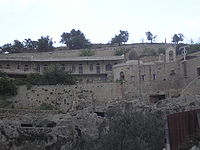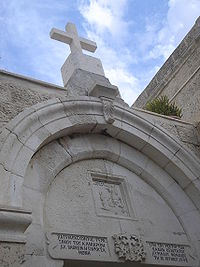
Aceldama
Encyclopedia


Judas Iscariot
Judas Iscariot was, according to the New Testament, one of the twelve disciples of Jesus. He is best known for his betrayal of Jesus to the hands of the chief priests for 30 pieces of silver.-Etymology:...
, one of the followers of Jesus
Jesus
Jesus of Nazareth , commonly referred to as Jesus Christ or simply as Jesus or Christ, is the central figure of Christianity...
.
The earth in this area is composed of rich clay and was formerly used by potters. For this reason it was formerly known as the Potter's Field
Potter's field
A potter's field was an American term for a place for the burial of unknown or indigent people. The expression derives from the Bible, referring to a field used for the extraction of potter's clay, which was useless for agriculture but could be used as a burial site.-Origin:The term comes from...
. The clay had a strong red colour, which may be the origin of the modern name. More recently it was used as a burial place for non-Jews. It was used for this purpose up to the first quarter of the nineteenth century.
During the era of the Crusades
Crusades
The Crusades were a series of religious wars, blessed by the Pope and the Catholic Church with the main goal of restoring Christian access to the holy places in and near Jerusalem...
, it was used to bury the fifty or more patients who died each day in the hospital run by the Knights Hospitaller
Knights Hospitaller
The Sovereign Military Hospitaller Order of Saint John of Jerusalem of Rhodes and of Malta , also known as the Sovereign Military Order of Malta , Order of Malta or Knights of Malta, is a Roman Catholic lay religious order, traditionally of military, chivalrous, noble nature. It is the world's...
in Jerusalem.
Christian tradition connects it with the death of Judas Iscariot, who is supposed to have bought it with the money
Thirty pieces of silver
Thirty pieces of silver was the price for which Judas Iscariot betrayed Jesus, according to the Gospel of Matthew 26:15 in the Christian New Testament. Before the Last Supper, Judas went to the chief priests and agreed to hand over Jesus in exchange for 30 silver coins...
that he received for betraying Jesus
Jesus
Jesus of Nazareth , commonly referred to as Jesus Christ or simply as Jesus or Christ, is the central figure of Christianity...
. In this account (Acts of the Apostles
Acts of the Apostles
The Acts of the Apostles , usually referred to simply as Acts, is the fifth book of the New Testament; Acts outlines the history of the Apostolic Age...
1:19) Judas fell over in this field in such a way that his intestines burst out and he died. This would imply that the name refers to the blood of Judas.
In a different version (Gospel of Matthew
Gospel of Matthew
The Gospel According to Matthew is one of the four canonical gospels, one of the three synoptic gospels, and the first book of the New Testament. It tells of the life, ministry, death, and resurrection of Jesus of Nazareth...
27:7) Judas hanged himself after returning the money to the Temple authorities, who then used the money (because it was deemed blood money, which was illegal to put into the treasury) to buy a field called the Potter's Field, which was then used as a burial place for impoverished foreigners. Here the implication is that the name refers to the blood of Jesus.
The Akeldama (Hakl-ed-damm) of today presents as a large, square sepulchre, of which the southern half is excavated in the rock, the remainder being built of massive masonry. In the center stands a huge pillar, constructed partly of rough blocks and partly of polished stones. Much of its clay was taken away by Empress Helena
Helena of Constantinople
Saint Helena also known as Saint Helen, Helena Augusta or Helena of Constantinople was the consort of Emperor Constantius, and the mother of Emperor Constantine I...
and other prominent Christians, to make sarcophagi.
It lies on a narrow, level terrace on the south face of the valley of Hinnom
Gehenna
Gehenna , Gehinnom and Yiddish Gehinnam, are terms derived from a place outside ancient Jerusalem known in the Hebrew Bible as the Valley of the Son of Hinnom ; one of the two principal valleys surrounding the Old City.In the Hebrew Bible, the site was initially where apostate Israelites and...
.
Later
In his Onomasticon (ed. Klostermann, p. 102, 16) Eusebius says the "field of Haceldama" lies nearer to "Thafeth of the valley of Ennom". But under the word "Haceldama" (p. 38, 20) he says that this field was pointed out as being "north of Mount SionMount Sion
Mount Sion is a Gaelic Athletic Association club located in Waterford City, County Waterford, Ireland, founded by Brs O'Connor and Malone, teachers in the above school...
". St. Jerome changed this to "south of Mount Sion" (p. 39, 27).
In the twelfth century, the crusaders erected beyond the field, on the south side of the valley of Hinnom, a large building now in a ruined condition, measuring seventy-eight feet in length from east to west, fifty-eight feet in width and thirty in height on the north. It is roofed and covers towards the southern end several natural grottoes, which were once used as sepulchres of the Jewish type, and a ditch is hollowed out at the northern end which is sixty-eight feet long, twenty-one feet wide and thirty feet deep. It is estimated that the bones and rubbish accumulated there form a bed from ten to fifteen feet thick. Akeldama has been the property of the non-United Armenians since the sixteenth century.
In 1892 the Greek Orthodox Church built a monastery at the site, named after Saint Onuphrius
Onuphrius
Onuphrius or Onoufrios , venerated as Saint Onuphrius in both the Roman Catholic Church and Eastern Catholic Churches; Venerable Onuphrius in Eastern Orthodoxy and Saint Nofer the Anchorite in Oriental Orthodoxy, lived as a hermit in the desert of Upper Egypt in the 4th or 5th centuries.-Life and...
. Many burial caves have been identified in and around the monastery.
See also
- Aramaic of JesusAramaic of JesusIt is generally agreed that the historical Jesus primarily spoke Aramaic, perhaps along with some Hebrew and Greek . The towns of Nazareth and Capernaum, where Jesus lived, were primarily Aramaic-speaking communities, although Greek was widely spoken in the major cities of the Eastern Mediterranean...

